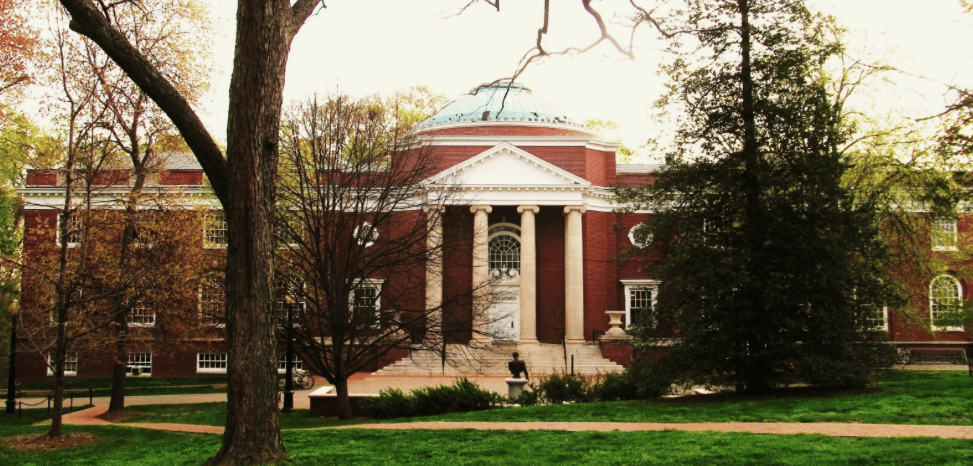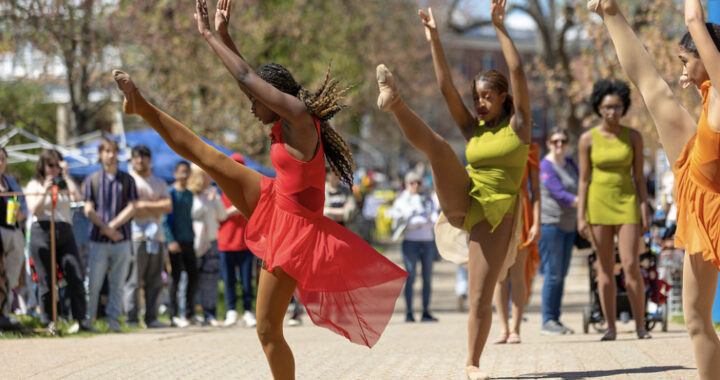Report argues for renaming of Trinkle among other measures
6 min read
Trinkle Hall will potentially be renamed. (The Blue & Gray Press)
By Ginny Bixby
Associate Editor
The Campus Environment Presidential Ad Hoc Committee hosted two open forums on October 28 and 30 to discuss its recently released report. The forums were held in the Digital Auditorium and were hosted by Michael Spencer, chair of the committee and historic preservation professor, and Cedric Rucker, associate vice president and dean of Student Life.
Eight faculty members and two students, who have now graduated, served as volunteers on the committee, which was formed in 2017. According to the report, the committee was charged by the Board of Visitors with “…conducting an audit of the public displays of history and culture in the campus common areas, including academic and administration buildings and residence halls, and to make recommendations where appropriate” and “making sure that the physical environments on our campuses more generally reflect our commitment to diversity and inclusion.” The recommendations will be reviewed by Paino and the Board of Visitors.
Twelve faculty attended Monday’s forum in addition to one student reporter, while 26 students and eight faculty members attended Wednesday’s forum. Many of the students in attendance at the second forum were representing the UMW chapter of the NAACP.
The report covers many issues relating to representation in public displays, but Spencer highlighted three of the committee’s recommendations as the most commonly asked about— renaming Trinkle Hall, concealing the representation of Robert E. Lee in George Washington Hall murals, and preserving and contextualizing the Monroe Hall murals, all by the year 2024.
Renaming Trinkle Hall
Many students at the forum voiced their support for changing the name of Trinkle Hall. According to page 57 of the report, the committee recommends that “Trinkle Hall should be renamed as the values the name embodies run contrary to the University’s ASPIRE document and the University’s mission as a whole.”
E. Lee Trinkle was the governor of Virginia from 1922 to 1926 and was a public supporter of segregation and eugenics. Trinkle signed the Racial Integrity Act of 1924, which was created to preserve racial hierarchies and was promoted by white supremacists and eugenicists.
Spencer said that the committee used Yale University’s considerations about renaming, which include evaluating if the legacy is at odds with the mission of the university, and whether or not the building plays a significant part in the life of the campus.
“Trinkle’s legacy, especially with the eugenics movement and the Sterilization Act of 1924 are in direct conflict with our current mission and objectives at the university,” said Spencer.
Spencer said that Trinkle Hall’s prominent presence on campus played a role in the committee’s recommendation to rename it. However, it will be up to the Board of Visitors whether or not it is ultimately renamed.
Sophomore Brianna “Breezy” Reaves said she came to the forum with other members of the NAACP chapter because she felt it was important to express herself as a black student at a predominantly white institution (PWI).
“When it comes to safety and representation, it’s very important that I show up and I make my issues known, that way I can hold the administration and any parties involved accountable,” she said.
Reaves is passionate about renaming Trinkle Hall.
“It’s a totally different thing to attend a predominantly white institution that still encapsulates, and still promotes or ignores the obvious hypocrisy of Trinkle Hall being located on a campus in which we promote diversity and inclusion,” said Reaves.
The College of William and Mary and Radford University both have buildings named Trinkle Hall as well. Trinkle helped fund the construction of the buildings at UMW and William and Mary.
“A lot of PWIs are good at being diverse, but a lot of PWIs aren’t good at being inclusive. Being inclusive would mean that you are including the voices of those you are trying to diversify the community with, and that you are listening to them when they say ‘we don’t want to [go to] an academic building [named after] a racist,” said Reaves. “The academic buildings, the residence halls, the buildings owned by the university are a representation of the community. So if you have a building named after Trinkle —a racist, a segregationist— that says something about the community.”
Spencer said that if the Board of Visitors votes to rename Trinkle Hall, a renaming committee would be formed and students could be a part of the process, and would also be able to suggest name suggestions. Several students at the forum voiced support for renaming Trinkle Hall after James Farmer.
“One of the biggest ironies on this campus is that we have James Farmer [statue] right across from Trinkle Hall,” said Rucker.
Committee recommendations
The
committee conducted a survey of other universities to see what actions
they’d taken when renaming and evaluating displays on campus. Erin
Devlin, professor of history and American studies is one of the members
of the committee who contributed extensive research to this report.
“That included looking at universities that ultimately chose not to change names as well as universities that did choose to change names,” said Devlin.
Devlin said that formulating the report has been a very deliberative two year process that examined not just permanent and prominent campus displays, but also images and text such as those displayed on bulletin boards.
“We talked to faculty, we talked to staff, we talked to students, we talked to alumni in a series of focus groups last spring and into this fall in order to get a sense of how different stakeholder groups in our community felt about our physical environment on this campus and representations of our institutional history in that space,” said Devlin.
Other issues addressed in the forums included the potential concealment of the murals in Monroe Hall. Spencer explained that concealment is a temporary historic preservation technique that would protect the murals while the university works on preserving them for the future. The committee has also recommended creating displays that would contextualize the murals in Monroe and George Washington Halls, as well as potentially covering the image of Robert E. Lee in George Washington Hall.
Concerns about accessibility
Jessica
Machado, director of the Office of Disability Resources, said at the
forum that she was concerned because people with disabilities were not
included among the underrepresented groups mentioned in the report.
“I want to make sure that there is an emphasis on making sure that we’re considering disability as a component of diversity, especially because we have such a large population of students with disabilities on this campus,” said Machado. She recommended that the committee consider ways in which visual displays could be made more accessible for students with visual impairments.
A student with a visual impairment also asked for disabilities to be considered when evaluating the displays and noted that she was unable to access and read the report because of her disability. Spencer and Sabrina Johnson, vice president for Equity and Access, said that they would work to find a way to make the report accessible for those with visual impairments.
Moving forward
Freshman Maya Jenkins said she came to the forum with the NAACP chapter because she cares about UMW and wants all students to feel safe and included on campus.
“One of the main [reasons] I loved this university when I came to visit was that I felt safe. I felt like I could be my own self… I wasn’t targeted. But the Patriot Front and other racially targeted [incidents] on campus have reminded me that maybe that safety isn’t real, and I still love this university so I want it to feel safe for other students,” said Jenkins.
“I hope that after I’m here, there’s going to be more black and brown students, more LGBTQIA+ students coming here, so I just feel like it would be great for something like Trinkle to be [renamed] because he represented something that we don’t believe in…it makes us feel unsafe.”
Spencer said that he would start editing the report immediately after the forum to include the comments and concerns that were addressed. He will distribute the revisions to the committee, who will edit the report and send it to President Paino within a week. The revised report will be addressed at the Nov. 15 Board of Visitors meeting, which is open to the public.












Let’s just get rid of all the buildings names and make everyone happy